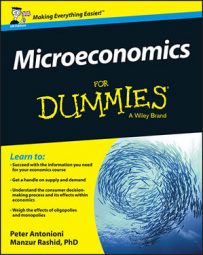Understanding the key definitions in microeconomics
Microeconomics comes complete with its own set of vocabulary, which can sometimes be confusing. To get a true feel for microeconomics, three key terms must be defined and understood. Those terms are:
-
Utility: Utility is the value people get from making a choice. You can find out how much utility a consumer gains by working it out from the choice they make. Consumers optimize — get the best level of utility they can, given that they have to do so within a budget constraint.
-
Profits: Profits are what’s left over from a firm’s revenue once all relevant costs have been accounted for. Firms try to make as much profit as they can, and they do this by producing until marginal revenue — the revenue gained from adding an extra unit — equals marginal cost – the cost of producing that extra unit.
-
Markets: Markets are places where consumers and firms trade. In a model of a market, consumers optimize their utility and firms try to maximize their profits. The price and quantity in the market will be the affected by lots of things — from the number of firms in the market to the income, or valuations of consumers.
Understanding the prisoner's dilemma in microeconomics
The prisoner’s dilemma can help you better understand microeconomics. In the prisoner’s dilemma, two people are arrested for a crime and put in separate rooms so that they can’t communicate. The authorities make the same offer to both, one that means that their best option if they could communicate is unattainable. Because neither party can fully trust the other they will default to a Nash Equilibrium that is not as good as the collective best outcome.
In strategy, a Nash Equilibrium is the condition where each player is doing the best they can, given that all other agents are also doing the best they can. A Nash Equilibrium is the best any individual player can do, but it’s possible that a better collective outcome could exist if players were better at co-operating with each other.
So, what’s the Nash Equilibrium used for in cases like the prisoner’s dilemma?
-
Cartels: If cartels could make legally binding contracts then it is possible that they could co-operate and act as a single monopoly. But since cartels are illegal, no one can make that contract, therefore the members can never fully trust each other.
-
Organized crime: Organized crime is an attempt to beat the prisoner’s dilemma. The syndicate uses its power to ensure that none of its members have an incentive to cheat.
5 reasons why markets fail
Understanding why markets fail is a key element in understanding microeconomics. Markets can fail for a number of different reasons, but the two most common are when a market provides something society doesn’t want, or doesn’t provide something society does want. Other reasons include the following:
-
Information: If consumers and producers do not have complete information then the problem is called asymmetric information. A lemon market — a market where there are lots of low quality products and you can’t tell before buying what the product quality is — is one example.
-
Too Few Property Rights: If no property rights are assigned then the good is called a common good and individuals will have an incentive to over-use it — as no one is paying for using it! The Tragedy of the Commons is an extreme example of this situation.
-
Too Many Property Rights: If a product depends on other things — for example earlier research — and there are property rights assigned to each of those things, then a market can fail because paying for the use of those properties is too high a fraction of total cost. This is called the Anti-Commons effect.
-
Public Goods: Public goods are not excludable, which means you can’t exclude anyone who hasn’t paid for the good — an example is street lighting. Markets find it hard to price these goods, so they tend to be produced collectively or through philanthropy
-
Externality: An externality is a cost or benefit that falls on a third party; for instance, if you buy land and build a factory but someone nearby is affected by your emissions.
Classifying types of markets in microeconomics
Microeconomists compare different types of market depending on the number of firms in the market, the ease of entering the market and the degree to which products sold are similar. There are four main types are:
-
Perfect Competition: A very large number of firms sell to a very large number of consumers. Firms make an identical product, and consumers are perfectly informed about prices and quantities. An example might be a fruit and veg market.
-
Pure Monopoly: A pure monopoly is the only firm selling in a market, and there may be high entry or exit costs. Monopolies will produce less for a higher cost. Consumers will get worse welfare under monopoly, and society as a whole will take some part of the loss – a deadweight loss.
-
Oligopoly: Oligopolies are markets where there are only a few competitors, and probably high entry costs. Oligopolies will tend to produce more than monopolies but less than forms in perfect competition – the result depends on how firms compete with each other.
-
Monopolistic Competition: In a monopolistically competitive market firms make different products from each other. As a result they behave like monopolies in the short run and competitive firms in the long run. Firms in monopolistic competition have to consistently invest in their product to keep themselves making higher profits.

